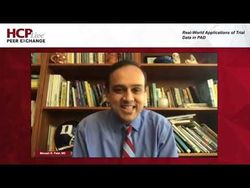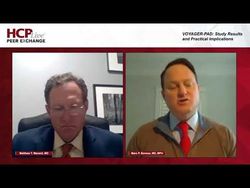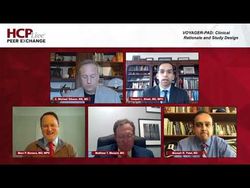Advances in the Management of Peripheral Arterial Disease - Episode 19
Peripheral Arterial Disease: Future Directions in Care
Transcript: Deepak L. Bhatt, MD, MPH: Let’s move on to your thoughts about the future of PAD [peripheral artery disease] and its management. I’ll start with you, Mike. What do you think is really big out there, or [what are the] unanswered questions? What’s the next big thing in your opinion?
C. Michael Gibson, MS, MD: I can look at the peripheral space similar to how I looked at the coronary space in the 1990s. It’s changing so quickly, on both the drug and the device side. All of you are going to make important contributions there. It’s going to be tougher to solve in some ways than the coronary side, given the dynamics of the peripheral vasculature. But I know all of you are up to the challenge.
Deepak L. Bhatt, MD, MPH: Those are really good thoughts. Matt, what do you think in terms of PAD, its future, and the big unanswered questions that you hope will be addressed? What’s the newest thing?
Matthew T. Menard, MD: Certainly, curing or preventing atherosclerosis would be top of the list. But we’ve talked about education. I really do think there’s a lot of room to move. To cycle back to 1 of your earlier questions in terms of education, we’re starting to cross-populate our societal messaging, and that’s going to be paramount. Certainly more of that would be beneficial alongside education of both the public and my world of vascular surgery.
I certainly think we’ve got challenges. The subpopulation of critical limb ischemia [CLI] was studied in VOYAGER PAD, but I do think the next wave of trials should be looking specifically at what people have mentioned is clearly the highest-risk group of folks that we struggle with the most, who have the most reinterventions and really soak up the most health care dollars. That’s high on the list. Sorting out the individual algorithms, so that we all have syntax. We don’t have anything like that currently in terms of how to look at an angiogram and figure out what therapy is best. The next wave of targeted therapy, both pharmacological and nonpharmacological, is important.
Deepak L. Bhatt, MD, MPH: Really insightful answer. I can turn to you next, Marc, with the same question. What’s the next big thing? What are you excited about? What are you working on?
Marc P. Bonaca, MD, MPH: I agree with the comments that have been made. PAD is so far behind coronary disease in terms of our understanding of the biology. There are a couple of major themes. We have to relearn the epidemiology of what PAD is, and I think EUCLID, which Manesh led, and VOYAGER PAD are 2 studies that really tell us it’s different from coronary disease. All atherosclerosis is not the same, and the risks that patients face, even the modes of mortality and other things, are quite different. We have to relearn the epidemiology. We have to understand the biology and understanding the anatomic predictors. We know in coronary disease that it’s not always the most narrow stenosis that leads to the next MI [myocardial infarction]. We have great studies to show that. We really don’t know anything about the anatomy and how that predicts different types of events and so on.
A lot of the outcomes that we talk about in PAD are multifactorial. We talk about the SGLT2 inhibitors and amputation. Amputation is something that happens to people where it’s an outcome that we measure, but it can happen for infection or ischemia or other things. I’m really excited about studies that are helping to elucidate who these populations are in PAD and the biology of these outcomes. What we’re going to see is that there are going to be targeted therapies for different types of patients in different settings. I hope that leads the way to better therapies for a really difficult population to treat.
Deepak L. Bhatt, MD, MPH: Great. As our final word, I’ll just turn to Manesh and ask you the same question. What is the future of PAD? What do you think are the important questions that we as a medical community need to address?
Manesh R. Patel, MD: First, thanks, Deepak. It’s a pleasure to be on a panel with a lot of the people who have led a lot of the research and work in PAD or atherosclerosis for quite some time. If you think about PAD in the context of how we think about COVID-19 [coronavirus disease 2019] right now, I’m struck by 3 big messages. On treatment, Matt and his colleagues in vascular surgery and endovascular specialists have done the BEST-CLI trial. Endo versus surgery is a question that will be important. We’re lucky enough to be doing a registry with him regarding that. We’re going to learn a lot about the epidemiology and the outcomes of those patients with critical limb ischemia who are the ones who probably get our attention the most.
Regarding actual medical treatment, as many have said, we haven’t focused on PAD even though we’ve lumped it in with all the other cardiovascular therapy. Some simple examples are how low can you get the LDL [low-density lipoproteins]. Even though we’ve seen observational data from big trials, can we be looking with some of the new therapies to say, do we effect the limb outcomes prospectively or randomly in PAD patients if we get their LDL as low as we think we should? How about the diabetic medications? Some have risks, some have possibly a benefit.
Finally, post COVID-19, I envision us being much more telemedicine based. Can we take our patients with PAD and capture their symptoms? Can we be much more oriented on exercise and rehabilitation in a way that we weren’t before to potentially manage a population that can tell us their symptoms to see if they improve? I suspect that’s where we’re going to have this improved payment because it’s not just going to be precision therapy. We’re going to get payment for precision care. If those patients have improving symptoms, are on the right therapies, are getting their LDL low, or are getting the right care, those are going to be the doctors who are part of that better care.
Deepak L. Bhatt, MD, MPH: Great. Those were wonderful comments. I really want to thank all 4 of you for a wonderful discussion, and I’d also like to thank the viewing audience. Hopefully you found this HCPLive® Peer Exchange® discussion to be useful and informative. It’s a particularly challenging time for all of us with this COVID-19 pandemic. But it’s important to continue education efforts to provide our patients the best care possible. Thank you to the faculty for participating in this, especially under rather stressful circumstances. And thank you to the audience for taking time out of your busy day to join us.
Transcript Edited for Clarity



